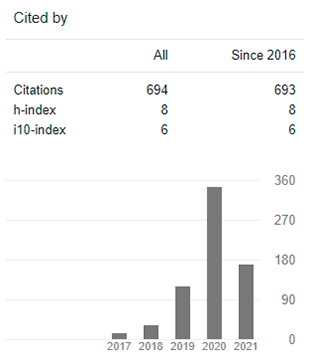Teaching Strategies for the Conservation of the Cruz Paredes Municipality State Swamp Creek Barinas 2016
DOI:
https://doi.org/10.29394/scientific.issn.2542-2987.2017.2.4.11.186-203Keywords:
pedagogical strategies, conservation, social participationAbstract
Research aims at teaching strategies for the conservation of the Gorge "the swamp" aimed to raise awareness among the inhabitants of "The Center", parish Barrancas, Cruz Paredes municipality, Barinas State; was of type descriptive, supported in the research of field and informed in a project feasible; Techniques and information collection instruments used the questionnaire with Likert scale; the validity and reliability on the judgement of experts-Alpha of Cronbach. The population was of thousand six hundred ten (1610) inhabitants of the sector the Center; of which it took a shows simple random to the random of fifteen (15) people. This information allowed us to identify some of the inhabitants of the sector to have knowledge that this source of water is a natural resource that sustains a biodiversity of flora and fauna that are unique of the municipality; a percentage of people has knowledge that the felling and burning in areas near the basin of the ravine are harmful to the life of this ecosystem; with all this is recommended apply strategies pedagogical of conservation environmental in them inhabitants of the sector the Center to strengthen the values of conservation to involve them in the solution of their problems.
Downloads
References
Cano, E. (2007). Las competencias docentes, el perfil del nuevo docente. Caracas, Venezuela. [Documento en Línea]. Recuperado de: https://books.google.co.ve/books?id=s1V7CAAAQBAJ
Dagnubys, J. (2009). Estrategia de Intervención Comunitaria para la Conservación y Mantenimiento del Rio Santa Bárbara del año 2008. Municipio Ezequiel Zamora del estado Barinas, Venezuela.
Gabriela, C. (2010). “Estrategias Pedagógicas y de Sensibilización en la Educación Ambiental”. Municipio Guanare, Estado Portuguesa Venezuela. [Documento en Línea]. Recuperado de: http://app.vpa.unellez.edu.ve/bibliotecavpa/opac_css/doc_num.php?explnum_id=11
Hernandez, E. (2011a,b). Gestión del Patrimonio Natural, Modulo 6. CCPB, Programa de Desarrollo de Capacidades para el Caribe, para el Patrimonio Mundial. La Habana: UNESCO, págs. 68. Recuperado de: http://whc.unesco.org/document/107154
León, A. (1998). Pedagogía ambiental Enciclopedia de Pedagogía / psicología (1ra. edición). P521 Alfatemática S.A. de C.V.
Ley Orgánica del Ambiente (2006). Gaceta Oficial N.º 5833e. Publicada el 22 de diciembre. [Documento en Línea]. Recuperado de: https://es.scribd.com/doc/47588555/LEY-ORGANICA-DEL-AMBIENTE
Sampieri, H. (2010). Metodología de la investigación. México D.F. Mexicana, Reg. Núm. 736. [Documento en Línea]. Recuperado de: http://www.academia.edu
Sampieri, H. (2006). Metodología de la investigación. [Documento en Línea]. Recuperado de: https://scholar.google.co.ve/citations?user=Sl208icAAAAJ&hl=es&oi=sra
Downloads
Published
How to Cite
Issue
Section
License
Copyright (c) 2017 INDTEC, C.A.

This work is licensed under a Creative Commons Attribution-NonCommercial-ShareAlike 4.0 International License.
The content of the journals of this site, are under a Creative Commons Attribution-Noncommercial-Share Alike 4.0 International License.













